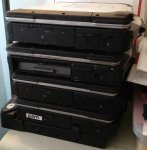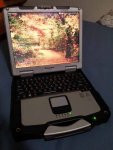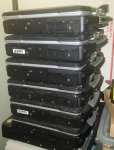Ive always liked how cops have them in their cars. I used to build computers but I'm so outdated now. Can you order those parts from one of the many computer sites?
Components are all still the same though, right?
The CF-30 (Core 2 Duo) I have a bunch of in the pictures is now
replaced by the CF-31 (Core i5). This makes "new" parts harder to get from resellers (not your BestBuy, Fry's Eletronics, NewEgg, CDW, etc...). In general what you are finding now is resellers who supported Government contracts are liquidating their inventories of CF-30 parts (most of it ends up on eBay), so new parts are actually available. That said, there are some basic standards that all laptops follow (even Panasonic): Memory is usually a "
SODIMM" very
easy to find as long as your chipset supports the capacity you require, Hard drives are usually a "
2.5-inch SATA", wireless cards are usually a "
Mini-PCIe Full length", displays are either
LVDS or the newer
Embedded-DisplayPort - then there is the same familiar USB, Ethernet, etc...
My dad taught me nearly everything I know about computers - he worked for the likes of TRW, and Unisys in the 80's on mind boggling projects - he defers to me now because most of the stuff the "old-timers" were familiar with is buried behind sexy UI's and much more code. Did you know you can nearly completely run Windows 7 and 8.1 from the command line still? Just about anything that you can do with a mouse click has a command-line function (it's how Microsoft starts with an OS, then they make it sexy before selling it

). Linux is the same way, anything can be done from the command line, then they build a nice GUI on top of it to make it easier for the general users - the main difference I've seen with Windows and Linux is that Windows is more worried about protecting their IP (since they sell it) so the bare code is harder to decipher (obfuscation), while Linux usually has stuff in plain-text.
...I mean other than Moore's Law halving the size of the transistor boards every two years, the game is still the same (+/-), isn't that right?...
They haven't been able to do that in a while (almost a decade), steps went 90, 60(60%), 45(75%), 32(71%), 28(88%), 20(72%), 14(70%), and next might be 10(71%). The transistor counts aren't necessarily doubling any more either (what the "law" states) - the
company I work for (please read my disclaimer) released a chip with
3.54billion transistors followed later by a chip with
5.2billion transistors in the same process (28nm) but the design uses roughly 1/2 the power to do about 150% of the work of the older generation. It's extremely fascinating work.
Moore's Law in my opinion is not exactly accurate any more, as with almost every other facet of life, we are getting better at using what we have more wisely. It just makes engineers lazy when they can rely on physical/process changes rather than getting their architecture tuned to be maximally efficient.














 .
.
